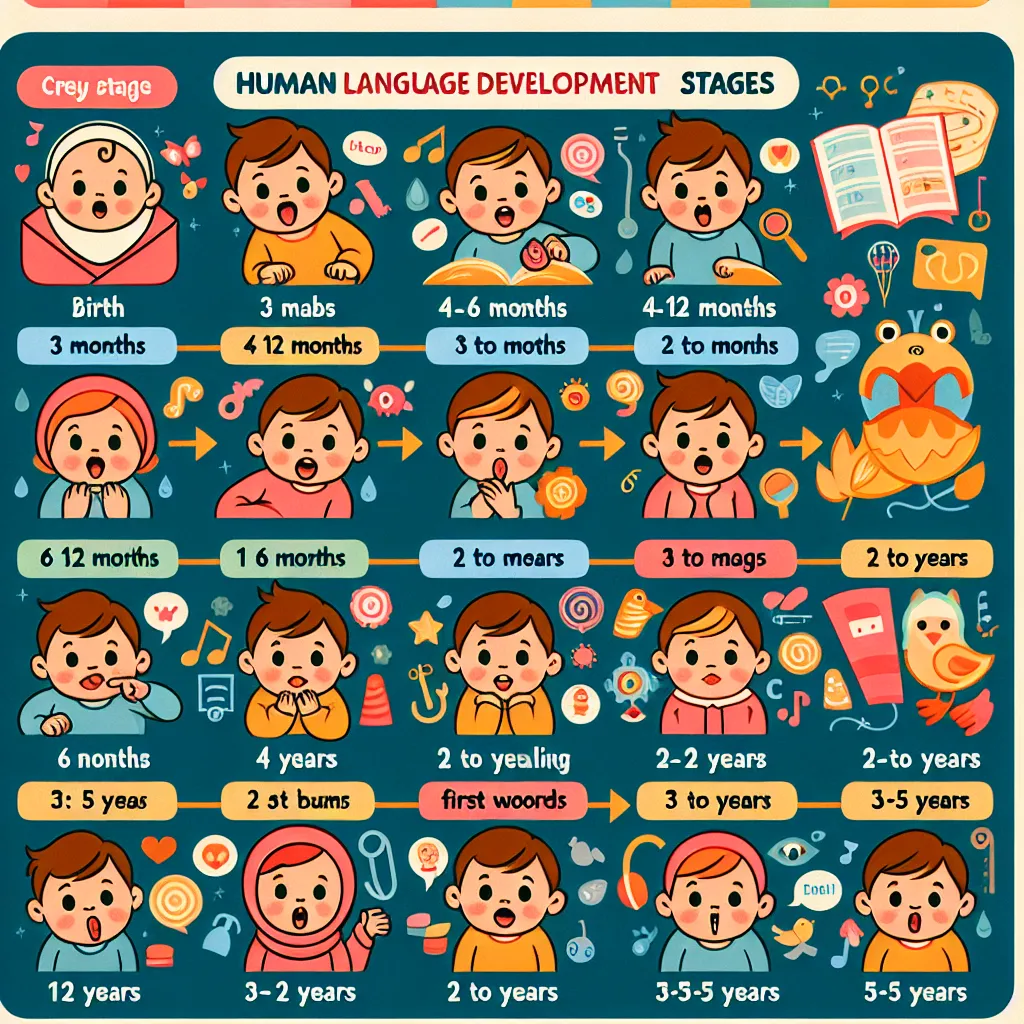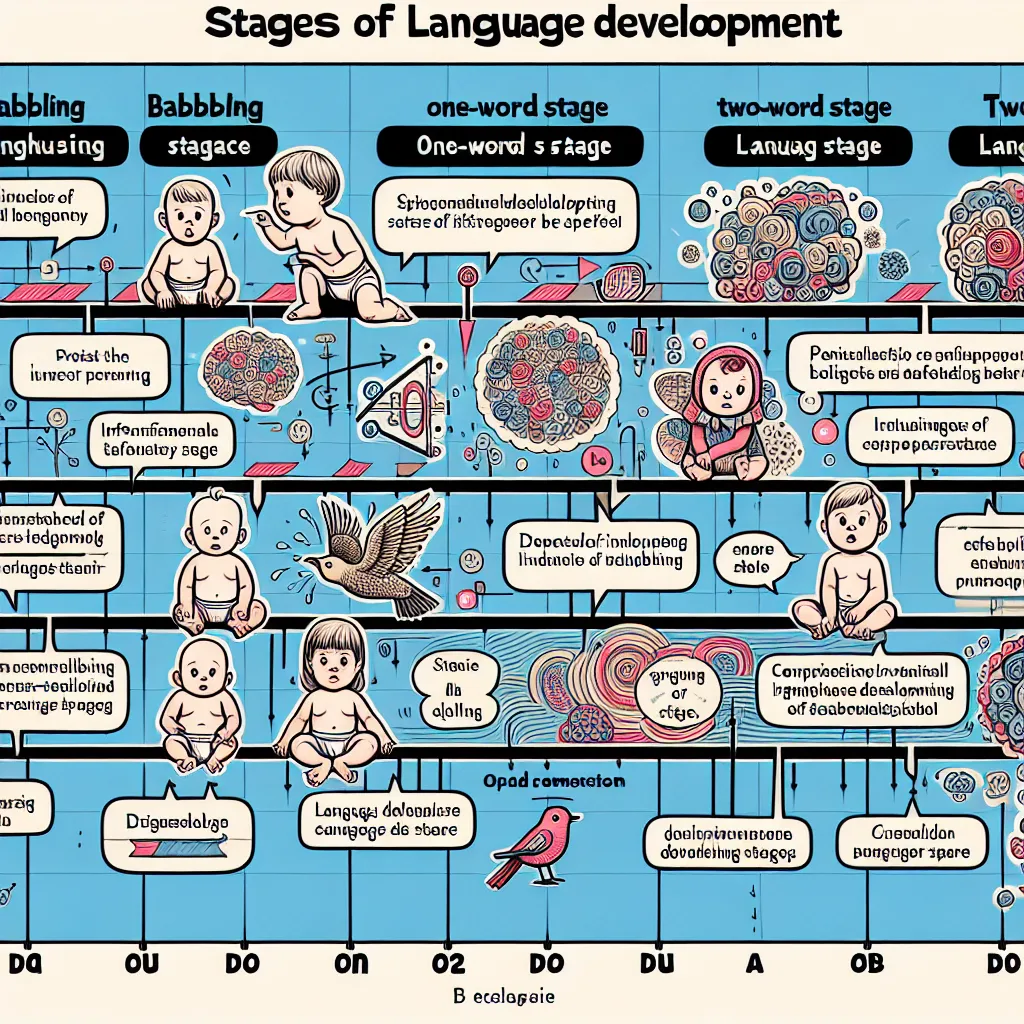Ask AI on The Internet
Question: List then define the pre-linguistic and the adult-like language stages in language development.
Language development is a complex process that progresses through various stages from infancy to adulthood. Here, we can categorize the stages into pre-linguistic (before the acquisition of formal language) and adult-like language stages. ### Pre-Linguistic Stages: 1. **Phonation Stage (0-2 months)**: - This stage is characterized by reflexive vocalizations. Infants produce sounds such as crying, coughing, and fussing that are primarily reflexive and not intended for communication. 2. **Cooing Stage (2-4 months)**: - Infants begin to produce cooing sounds, which are extended vowel sounds like "oo" and "aa." These sounds are usually produced in a happy and comfortable state. 3. **Expansion Stage (4-6 months)**: - During this stage, infants start to experiment with their vocal cords. They produce a variety of sounds including squeals, growls, and yells. Laughter also emerges in this stage. 4. **Canonical Babbling Stage (6-10 months)**: - Infants begin to produce repetitive consonant-vowel combinations, such as "ba-ba" or "da-da." These sounds become more speech-like and are the precursors to real words. 5. **Variegated Babbling Stage (10-12 months)**: - This stage features more complex combinations of sounds and syllables, such as "ba-da-ma." Infants experiment with different intonation patterns and rhythms. 6. **Jargon Stage (12-18 months)**: - Infants produce strings of sounds and syllables that mimic the intonation and rhythm of adult speech. Although it sounds like they are talking, they are not yet using real words. ### Adult-Like Language Stages: 1. **Single-Word Stage (12-18 months)**: - The child begins to use single words (also known as "holophrases") to represent whole sentences or ideas. For example, saying "milk" to mean "I want milk." 2. **Two-Word Stage (18-24 months)**: - The child starts to combine two words to form simple sentences, such as "mommy go" or "more juice." This marks the beginning of syntax development. 3. **Telegraphic Speech Stage (24-30 months)**: - Children begin to produce short and grammatically simplified sentences that lack function words ('the', 'is') and inflections, resembling telegrams. For example, "want cookie" instead of "I want a cookie." 4. **Early Multiword Stage (30-36 months)**: - The child's sentences become longer and more complex, incorporating elements of grammar such as plurals, basic prepositions, and simple verb tenses. Sentences like "Mommy is going" or "Big dog runs" emerge. 5. **Later Multiword Stage (3-4 years)**: - More complex structures like compound and complex sentences begin to appear. Children start using conjunctions to link ideas and expressions. Vocabulary and understanding of grammar increase substantially. 6. **Early School Age (4-7 years)**: - The child develops a more extensive vocabulary, refines grammar skills, and becomes more adept at conversation. Children also begin to acquire literacy skills. 7. **Later School Age to Adolescence (7-12 years)**: - Language skills become more sophisticated, including the use of more abstract and nuanced language. There is a greater understanding of syntax, morphology, and pragmatics. 8. **Adolescent and Adult-like Language (12+ years)**: - Language development continues with an increase in vocabulary, more refined use of language for different purposes, and the ability to understand and produce complex and abstract ideas. This stage includes the use of idiomatic expressions, advanced grammar, and specialized vocabulary related to different fields of knowledge. Language development is continuous and varies widely among individuals, but these stages provide a general framework for understanding how language skills evolve from infancy through adulthood.
Think your answer is better than the AI's? Post it below.
Other Most Relevant Posts:
 Ask AI: List then define the pre-linguistic and the adult-like language stages in
language development. (4)
Ask AI: List then define the pre-linguistic and the adult-like language stages in
language development. (4)
 Ask AI: Describe the typical milestones and progressions observed in language
development during this period.
(4)
Ask AI: Describe the typical milestones and progressions observed in language
development during this period.
(4)
 Ask AI: Describe the typical milestones and progressions observed in language
development during this period. (4)
Ask AI: Describe the typical milestones and progressions observed in language
development during this period. (4)
 1. **Language Development: Pre-Linguistic to Adult Proficiency**
2. **Emergent Literacy: Building Language Foundation**
3. **Grade R's Impact on Language Acquisition**
4. **Early Childhood Langua
1. **Language Development: Pre-Linguistic to Adult Proficiency**
2. **Emergent Literacy: Building Language Foundation**
3. **Grade R's Impact on Language Acquisition**
4. **Early Childhood Langua
If you want your question answered by an AI, click here.



Post your own comment: